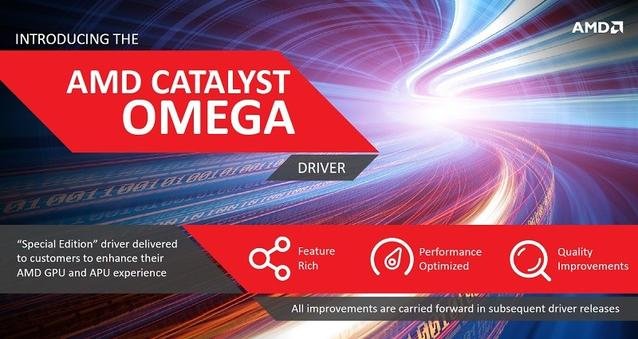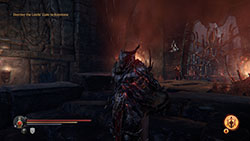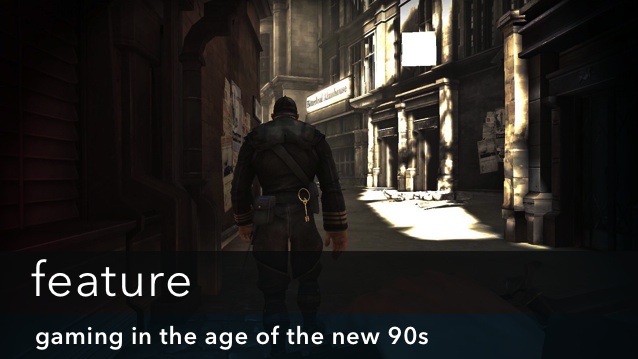


Graphics driver updates aren't often as exciting as the release of their physical counterparts. Sometimes they improve performance by certain percentages. Occasionally you find a few broken egg shells. That could be why people don't update too often, be it for their computers, high definition televisions, or the refrigerators that I'm sure now cool entire homes in addition to parfaits. As the old adage says, "If it ain't broke, don't fix it." But AMD's latest driver may just be worth ignoring that advice.
According to Robert Hallock, Catalyst Omega is one of the biggest drivers they've ever made. It was put through 441,000 automated test cases and 11,088 manual test cases on 600 different systems and 190 screen sizes. A significant amount of time was spent talking with the community to create and address a list of their most pressing concerns, as well. The outcome of that work includes more than 20 new features, performance improvements, and significant updates for developers. This is also the beginning of a new release cycle from AMD, with an annual plan for Omega-like drivers.
With that in mind, let's take a closer look at some of the more significant features Omega offers to consumers.
Virtual Super Resolution
Virtual Super Resolution is AMD's implementation of downsampling, a process that renders an application at a higher resolution and then resizes the image to fit your display's native resolution. Not only does this eliminate jaggies without the need for anti-aliasing, texture detail becomes more pronounced. Pictures speak louder than words, so a few comparisons are provided below. Take note of the vegetation in Dragon Age: Inquisition and the character's armor in Lords of the Fallen.
Dragon Age: Inquisition (Click to enlarge)
1080p 4K



Lords of the Fallen (Click to enlarge)
1080p 4k



Enabling VSR is as easy as checking a box in the Catalyst Control Center. As long as an application supports resolutions up to and including 3200 x 1800, new display options will be selectable in-game. This even applies to your desktop. An R9 285, R9 290, R9 290X, or R9 295X2 graphics card is required for VSR, but a future update will make it available to the R7 series in early 2015.
Rendering games at a higher resolution does have a performance cost, of course. Dragon Age: Inquisition ran at a solid 55 to 60 frames per second at 1080p and ultra settings on my R9 290. It dropped between 24 and 34 frames, generally favoring the former, when switched to 4K. 1440p sat in the middle. Batman: Arkham Origins showed a similar ratio, hovering around 120 at 1080p and 60 at 4K.
AMD Fluid Motion Video
Televisions can reduce motion blur and increase the framerate of video content by interpolating new frames between existing ones. AMD is applying that same technology to computers with Fluid Motion Video, and the results are strikingly similar to what you get on an HDTV. Judder is minimized while focus is maintained during sweeping shots.
Film purists won't like the excessive soap opera effect, however. Even at its lowest of the feature's three values, motion is exceedingly smooth. It also shares other visual artifacts. Ripples or tearing are visible on the edges of moving objects, particularly in scenes of high contrast. For the most part I didn't find it as distracting nor noticeable as it often is on an HDTV, but I would like to eventually see finer de-judder control.
An AMD 7x00 A-series APU or R7 260, R7 260X, R9 285, R9 290, R9 290X, or R9 295X2 graphics card, Blu-ray drive, Blu-ray disc, and Cyberlink's PowerDVD 14 software are required for AMD Fluid Motion Video.
Video Enhancements
Omega's additional video enhancements can be used with traditional players, such as Media Player Classic Home Cinema, XMBC, Windows Media Player, and VLC, though specific hardware is still necessary for their functionality. I was able to test Contour Removal (same AMD requirements as the above), a feature designed to remove compression artifacts from flat color areas. I did spot some improved consistency, but not enough without heavy scrutiny. Adjusting its strength via a slider in the Catalyst Control Center didn't have an appreciable effect.
1080p Detail Enhancement is a suite of clarity and compression removing features for low resolution content. This includes Edge-enhancement (sharpening), De-noise, Mosquitio Noise Reduction, and De-blocking (reduces macro-blocking). These are currently supported only on an AMD 7x00 A-Series APU or R7 285 GPU, so I wasn't able to evaluate them. Hopefully this is something that can be addressed later.
Performance Improvements
The performance gains under Omega for discrete GPUs are limited, but AMD Dual Graphics configurations now have access to the same frame-pacing enhancements first employed for CrossFire. Frame-pacing helps maintain a consistent framerate without large swings between the minimums and maximums. That should reduce the jittery experience multi-processor systems previously suffered with.
FreeSync
We may not have to wait much longer for FreeSync-equipped monitors, displays that support AMD's variable refresh rate to eliminate screen tearing and stutter, to hit the market. FreeSync is now enabled at the driver level. And with vendors now entering mass production, units should be available in 2015's first quarter. We'll have more to talk about on this subject once they've released, but it's exciting to see that snowball start to take shape.




 7 Twitch Streamers To Watch If eSports Aren't Your Thing
7 Twitch Streamers To Watch If eSports Aren't Your Thing How To Beta Test Pillars Of Eternity Patches On Steam
How To Beta Test Pillars Of Eternity Patches On Steam Assassins Creed 3 Glitches: Its Got a Few Bugs
Assassins Creed 3 Glitches: Its Got a Few Bugs Sleeping Dogs Walkthrough
Sleeping Dogs Walkthrough Top 10 Exotic weapons in Destiny and how to use them part 2
Top 10 Exotic weapons in Destiny and how to use them part 2